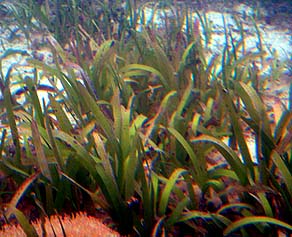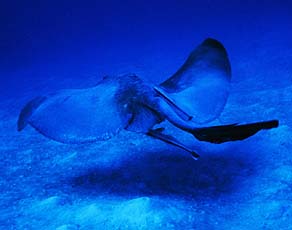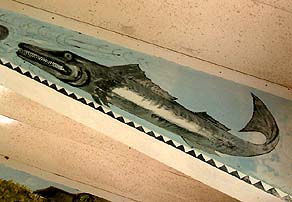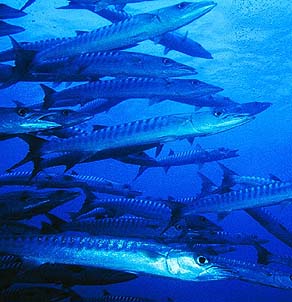 |
 |
 |
 |
||||
|
|
|
|
|
|
|
|
|
|
|
|||||||
|
|
|
|
Johnson and a friend go to check a fish trap.
|
|
"In Palau, there is different fishing for different places, for different times of the day, and for different tides," Noah states. "We break fishing into night and day, that’s the first distinction. Fishing at night, fishing during the day, and then different places, beginning from the shore all the way to the open water, and then different tides. For people in the east coast of Babeldaob, where they have extensive sea grass beds and sand flats, usually the most important form of fishing is harpoons."
|
||
|
|
||
"There are two basic spears: one with a single barbed head, attached to a thin bamboo pole, and then the other one we call the táod, is pronged one. Three or four prongs. Mainly you stand on the beach when the tide goes down, the fish come by, and you to throw your spear. It used to be pretty productive in the old days: get up in the morning before school, and come back with fish. So that’s the most simple one. "And then we have the spear fishing that you can do during the day where you have the high tide. You spear-fish in the sea grass beds using goggles. Of course in the old days, bows and arrows were used."
|
|
|
"You go in the morning when they have the low tides on the bay. You chew on a coconut, get a coconut oil that when you spit on the water, it clears it and you can see clearly, and you can use bow and arrow and simply a hand spear." "Mostly it was hand spears in the old days, then we moved to goggles and hand spears, and then to spear guns during the Japanese period. Then outside the reef, it takes the big spear gun, where you go down and spear the fish."
|
|
|
|
|
"There are set nets where you simply set your net and wait for the tide to go down, and then the fish will come to the back and you collect them. We did use the fish wiers, beng. They’re set on the reef, and then during the falling tide, the fish will get caught. These are built in places where the fish go down, so they collect in one area and then you have a place where you can close it up, keeping the fish inside. Or they’ll be trapped simply by the tide going down. Then you take your fish, and when the next tide comes, the remaining fish will go. When I was growing up in Ngiuál, my grandfather had one. But they are no longer in use now in Palau."
|
||
|
|
||
"In the old days, fish traps were made out of mangrove wood. The shape depends on what the trap is for. You have a different way of building it and setting it. And you set a trap and you put stones around it, and the fish will go inside. Fish traps are made differently in modern times. They probably use rebars for frames and chicken wire or other wires. "But the idea is the same: it’s a cage built like a tunnel and then set facing the place where fish migrate. They’re like Maine lobster traps except they’re big. We put stones around it, not so much so on top but mainly just on the sides, about half way up, so when fish would come, they’d think it’s a hole there to go through."
|
|
|
"Normally we don’t use bait. There is another type of trap that we use bait to lure the fish. These, you set your trap at places where fish normally migrate. And then there is one specifically used for a rudder fish that school, and they go feed, fill up, and they get trapped in this large trap, usually used in deep water. "But the main ones that we used when we were growing up were ones made from mangroves, from roots and vines that we got from the forest. We pull it in certain areas for certain fish—cod fish or parrot fish—and every few days you go and open the top, take the fish out, close it to clear it, and then if there is too much fish, you leave some in the trap. You take a few and then close the front so it doesn’t take any more fish. Then you take from it for a while and then set it again."
|
|
|
|
|
"Line fishing takes place mostly outside the reef, the bottom line fishing. Most open ocean fishing is trolling. In the old days it was more shark fishing, and that was mainly more sport than anything else. It’s called oungoáol. People went out to noose sharks. That was part of growing up, part of becoming a man, and it was very risky, but highly controlled and highly planned. It was tough and they would do it for sharks, where they go out in open ocean."
|
||
|
|
||
"But mainly the Palauans—at least the main-island Palauans, are lagoon fishermen. Because there was so much fish within the lagoons, we didn’t see a need to go out to fish for open ocean fish. "The taste for eating tuna is really mainly for the Southwest Islands people; otherwise eating tuna is a new thing for Palauans. Recently people are beginning to eat offshore fish, but people get tired of it very quickly because they are not used to it. We didn’t eat mahimahi. People just don’t like it. Perhaps it has to do with the fact that the insides spoil very quickly because of the food that they eat, and they don’t smell very good. We are more reef-fish eaters."
|
|
|
"In Palau, there are probably about three or four main species of fish that you know all about: you know the names, you know where they live, you know where they sleep, you know the color of their bones and you know how they’re arranged, and you know what they’re good for—whether they should be for children’s food or for your auntie or sister or for a family or what. "You know the fish when they hide: whether they dig into the sand or they hide in the coral inside or outside, or what coral is a favorite place for them to hide. So when you go fishing, if you want that particular fish, you have to go to certain area on the reef to find that fish. If you see it and it runs away, you know what rock it’s most likely going to go to. And if there are ten rocks, you know which rock it’s likely to be under." . |
"Some fish dig and hide in the sand, so don’t waste your time looking for it under the rock. You’ll want to search the sand, because it’ll be right there buried beneath the sand "We know they bury themselves, so if you have a net and this particular fish went for the net and he didn’t reach the net—and know that your net doesn’t have a hole— you know where that fish is going to be: it is buried in the sand. Sometimes you find the mound in the shape of the fish, and some fish bury themselves way deep."
|
|
|
"Or what we call the houses for that fish would have piles of coral nice and clean, so you go there and you know that the fish is there or the fish is not there. You take your spear and you poke it through and you can tell when you hit the fish. Just dig it up and the fish comes out. "It’s the same way with octopus (bokitang), with sting rays (rrull), and with turtles (uel). Turtles, you know where they feed, what tide they come in. Sting rays like to feed at certain tides: they don’t feed at the incoming tides but outgoing tides. Some fish feed incoming tides, some fish feed at outgoing tides; so a lot of things are happening."
|
|
|
|
|
"There are a lot of fish that Palauans like to eat. I think the rabbit fish (meas) is certainly a favorite fish. And most of the reef fish, especially algae-eating types of fish—surgeon fish (chum) or the parrot fish (kemeduckl , and the poll unicorn fish (cherangel). Most of those are preferred, and then some of the next preferred ones feed on other fish. Jacks and snappers and things like that.
|
||
|
|
||
"How you cook it all depends on the type of fish. Fishes are very different. You would not just say ‘I want to eat fish;’ you want to eat which fish, and how it’s cooked, because it’s cooked in different ways for it to be good. Cooking it over fire is usually a good way. Or boiled, steamed fish. Boil it in water with the leaves that go with it. We cook fish in coconut cream. "And more recently we’ve added frying and smoking and all kinds of things. Plus, we want to know where the fish came from. We want to know whether it’s fat or not, because we want fat fish. Fish that is not fat is not good. It may be a unicorn fish which people really like, but if it’s not fat then they wouldn’t want to eat it."
|
|
|
"If you know where it came from then most likely you know whether it’s fat fish, or good eating fish. If they come from outside the reef, they’re not very fat. They shrivel up and by then you don’t want to look at the fish. You want to check whether it’s really fat or not. "So when we go to the market, Palauans won’t just go and grab a favorite fish. We start with their favorite fish and then to check whether it’s fat or not. And if it’s not fat, then we will go to the next. And we are always thinking about how we’re going to cook it. "
|
|
|
|
|
"The most prestigious fish in Palauan culture is maml. This is the bumphead wrasse or Napoleon wrasse, and it’s a prestige fish. It’s easy to get wrasse. At night they sleep in shallow water. During the day you can spear it—it’s not hard to spear them. There are not as many as before, but there’s enough around. "But if I or my son would catch it, it would go to my sister or my auntie. It’s a fish that you want to give to the important women in the family—your sisters or your aunties. If you gave a wrasse to someone, it’s very meaningful. Just the name itself, it’s a very strong name. The old way of cooking it involves weaving a basket, and chopping it and cooking it in a basket—the head and other parts. "When it’s cooked, if you want to give the head to a certain person, then it’s packed in a woven basket, and boiled. They have very tender meat so once it is boiled, everything just kind of drops off. And when you cook it, it’s very tender and it’s never lean. It’s always fat."
|
||
|
|
||
Certain fish are held of special importance to peoples of different villages in Palau. In Airai, one of these is the barracuda. Johnson & Icheyad tell the story behind this: “One day Medechiibelau went fishing with his friends, the gods, in the lagoon here. And they came to a cave by one of the Rock Islands known as Omroteldelul—it is a rock island with a cave in it, where they were trying to distribute their catch. You know, that is Palauan custom: if you go fishing, you share whatever catch you get equally. "When you distribute fish, you pile them together. There were seven people, and you just go one by one. And you don’t try to be selective, you just kind of go around."
|
|
|
“There was one barracuda which Medechiibelau desired. But the first time they distributed the catch, he didn’t get the barracuda. So he would say, ‘let’s redistribute our catch again,’ and they would pile it over again and start redistributing it. "This happened seven times: they started distributing the catch
from the rock island, continuously, all the way until they were right
at the Bairamelengelarea there. That is when Medechiibelau got the
barracuda—somehow he got it—and then he says, ‘okay
it is all over now.’ Some how, he tried to manipulate the system.
And then he got his barracuda home."
|
|
|
|
| “So it became the practice and custom of the people of Airai Village, not to eat barracuda nor shark. If you catch a barracuda, you bring it to his house today. And you don’t eat shark even today. You don’t eat shark here, and if you catch a barracuda you bring it to his house. That is his share.”
The story of Medechiibelau and the shark is told in the Footprints chapter. Now we invite you to look at Palauan terminology regarding fish and fishing as presented in this chapter's Language page. Our next chapter focuses on the Land.
|
||
|
|
||
|
|
|
|
|
|

|
| Airai Home | Map Library | Site Map | Pacific Worlds Home |
|
|
|
|

|
|
|
|||
| Copyright 2003 Pacific Worlds & Associates • Usage Policy • Webmaster |
|||


















